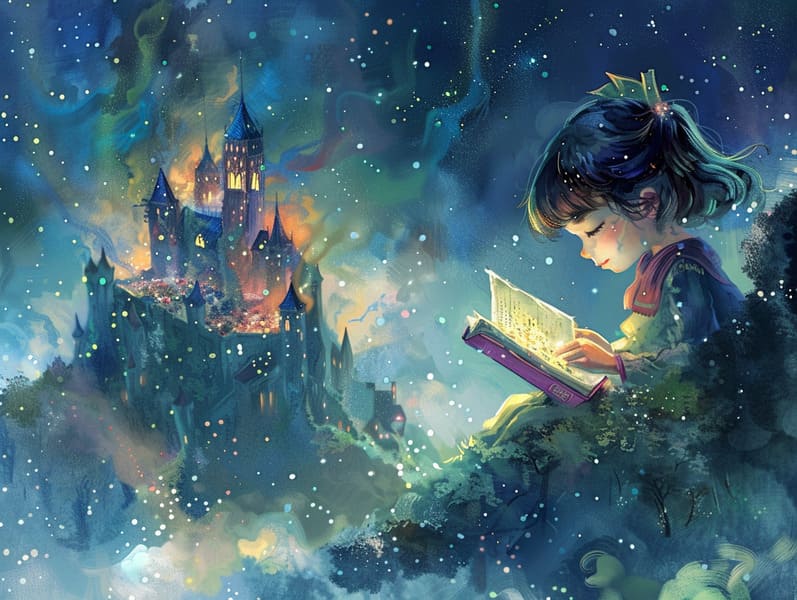
Old fairy tales have old origins. These tales have been relayed from one generation to the next long before they were ever documented. They developed from a variety of traditions, including Indigenous traditions. They were initially told among adults, often carrying themes and messages aligned with the societal norms and beliefs of the time.
The Grimm brothers, the two Grimm brothers, were among the first to compile and release many of these beloved tales. Their anthology, "Grimm's Folk Tales," included tales like "The Story of Cinderella," "The Bread Crumb Trail," and "Snow-White and Rose-Red," which have since become cornerstones in the world of children's fairy tales. Similarly, Hans Andersen's whimsical narratives, such as "The Sea Maid," and "The Story of the Ugly Duckling," have touched hearts worldwide, establishing their place in the pantheon of classic fairy tales.
Though they are old, classic fairy tales remain as meaningful as ever, especially as bedtime stories for kids. These charming stories are now available in various formats, including colorful picture books, enchanting animations, and digital storybooks.
Their persistent charm can be ascribed to several whimsical characteristics:
Significant Morals: Timeless fairy tales often present important moral lessons. Fairy tales like "The Boy Who Cried Wolf" teach the virtue of integrity, while "The Story of the Tortoise and the Hare" point out the benefits of determination and unpretentiousness. These narratives offer young ones clear distinctions between good and bad, forming their moral compass in a soft yet profound way.
Compassion and Insight: Traditional fairy tales frequently include heroes facing trials and tribulations, urging listeners to understand with their struggles and encourage their triumphs. For instance, "The Tale of Beauty and the Beast" points out the importance of valuing inner qualities to acknowledge the real character of a being, advancing compassion and comprehension.
Cultural Appreciation: Many classic fairy tales are deeply embedded in the cultural contexts from which they arose. Understanding these narratives can provide delightful insights into different customs, enhancing a sense of global appreciation and knowledge.
Fantasy and Imagination: The magical elements in traditional fairy tales—fairy godmothers—stimulate children’s visions. These tales carry readers to supernatural realms, engendering inventive thinking and a sense of wonder that persists a lifetime.
Traditional fairy tales are not only enchanting but also pedagogical. They act as bewitching tools in building various thinking and feeling skills in kids. When timeless fairy tales are told out loud, they strengthen verbal development by showing new terms and sophisticated sentence structures. This practice also develops listening skills and mental focus, as young ones follow the story, excited to see what happens next.
Furthermore, exploring the themes and characters of ancient fairy tales can improve cognitive skills and reasoning skills. Young readers are instructed to see patterns, guess what will happen, and grasp cause and effect. These debates also facilitate young readers speak out their thoughts and feelings, contributing to their emotional intelligence.
In today’s digital age, the existence of online fairy this site tales has made these stories more acquirable than ever. Web-based platforms and digital apps extend broad selections of Grimm's fairy tales that can be browsed or heard anytime, anywhere. Fairy tales spoken are particularly prevalent, extending an charming way for young ones to take part in these charming stories. Sound books and voiced videos carry characters and settings to life, often complemented by charming harmonies and melodies that elevate the tale journey.
The persistent attraction of classic fairy tales lies in their ability to transform to modern society while sustaining their central messages. Contemporary reimaginings of these tales often highlight more different figures and modern settings, making them meaningful to today’s audience. However, the key lessons of braveness, sympathy, and fairness remain unchanged, continuing to appeal to kids of all ages.
Old fairy tales also offer a sense of peace and knownness. They deliver a ordered narrative with a evident beginning, middle, and end, often closing with the culmination of conflicts and the triumph of justice over injustice. This reliability can be consoling for kids, granting a sense of reliability in an fluctuating world.
Ancient fairy tales continue to enthrall and guide new generations, maintaining their fascination and impact in modern society. As kids' bedtime tales, they allow a perfect blend of allure and teaching, enhancing moral values, empathy, and creativity. The abundance of digital fairy tales and the favor of fairy tales narrated ratify that these traditional stories remain accessible to new generations.
By protecting and conveying these tales, we continue to acknowledge the rich tapestry of creativity and cultural heritage. Whether you are discovering a colorful picture book, exploring a web-based collection, or listening on an spoken story, the captivation of ancient fairy tales is always within reach. These narratives convey of the perpetual spell of tales and its ability to link us across eras and regions.
If you are viewing a vibrantly illustrated book, delving into a cyber collection, or listening on an audiobook, the magic of bedtime fairy tales is always within reach.
These tales reveal of the enduring influence of narratives and its ability to gather us across epochs and places, casting a charm that delights and instructs alike.